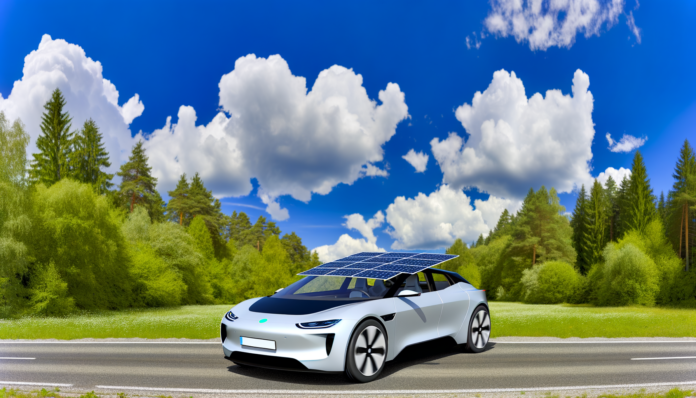Introduction
Overview of Eco-Friendly Commutes
In today’s rapidly urbanizing world, the need for efficient, eco-friendly, and sustainable transportation solutions has never been more critical. Traditional modes of transportation, heavily reliant on fossil fuels, contribute significantly to air pollution, traffic congestion, and greenhouse gas emissions. As cities expand and populations grow, the pressure on public transportation systems to evolve and meet these challenges is immense. Eco-friendly commutes, which prioritize reducing environmental impact and enhancing energy efficiency, are emerging as a vital component of modern urban planning. These sustainable transportation options include electric vehicles, bicycles, public transit systems, and, increasingly, solar-powered vehicles.
Importance of Sustainable Transportation
Sustainable transportation is essential for several reasons. Firstly, it addresses the urgent need to reduce carbon emissions and combat climate change. The transportation sector is a major contributor to global carbon dioxide emissions, with road transport alone accounting for a significant portion. By transitioning to sustainable transportation options, we can significantly reduce our carbon footprint and mitigate the adverse effects of climate change.
Secondly, sustainable transportation improves air quality and public health. Traditional vehicles emit pollutants that contribute to respiratory problems, cardiovascular diseases, and other health issues. By adopting cleaner transportation methods, we can enhance the quality of life for urban dwellers and create healthier communities.
Thirdly, sustainable transportation promotes energy independence. By utilizing renewable energy sources such as solar power, we can reduce our reliance on fossil fuels and diversify our energy portfolio. This not only enhances energy security but also stabilizes energy costs and reduces the economic impact of fluctuating fuel prices.
Introduction to Solar Powered Vehicles
Solar-powered vehicles represent a groundbreaking advancement in the realm of sustainable transportation. These vehicles harness the power of the sun to generate electricity, which is then used to propel the vehicle. Solar panels, typically installed on the roof or other surfaces of the vehicle, capture sunlight and convert it into electrical energy through photovoltaic cells. This energy can be stored in batteries for later use or used directly to power the vehicle’s electric motor.
The concept of solar-powered vehicles is not just a futuristic dream; it is becoming a practical reality. Advances in solar technology, battery storage, and vehicle design have made it possible to develop efficient and reliable solar-powered cars, buses, and even trains. These vehicles offer a myriad of benefits, including reduced carbon emissions, lower operating costs, and decreased dependence on fossil fuels.
Solar-powered vehicles are particularly well-suited for regions with abundant sunlight, but ongoing technological advancements are making them increasingly viable in a variety of climates. As the technology continues to evolve, we can expect to see more widespread adoption of solar-powered vehicles, transforming the way we commute and contributing to a more sustainable future.
In conclusion, the rise of solar-powered vehicles marks a significant step forward in the quest for eco-friendly commutes. By embracing this innovative technology, we can reduce our environmental impact, improve public health, and achieve greater energy independence. The journey towards sustainable transportation is well underway, and solar-powered vehicles are poised to play a pivotal role in shaping the future of mobility.
The Technology Behind Solar Powered Vehicles
How Solar Panels Work
Solar panels, also known as photovoltaic (PV) panels, are the cornerstone of solar-powered vehicles. These panels are composed of numerous solar cells made from semiconductor materials, typically silicon. When sunlight strikes these cells, it excites electrons, creating an electric current. This process, known as the photovoltaic effect, converts sunlight directly into electricity.
The efficiency of solar panels is a critical factor in their performance. Modern advancements have led to the development of high-efficiency solar cells that can convert a greater percentage of sunlight into usable electricity. Innovations such as multi-junction cells, which layer different semiconductor materials, have pushed efficiency rates even higher, making solar panels more viable for automotive applications.
Integration of Solar Panels in Vehicles
Integrating solar panels into vehicles involves more than just attaching them to the roof. The design and placement of these panels are crucial for maximizing energy capture while maintaining the vehicle’s aerodynamics and aesthetics. Typically, solar panels are installed on the roof, hood, and sometimes even the sides of the vehicle to capture as much sunlight as possible.
The electricity generated by these panels is either used directly to power the vehicle’s electric motor or stored in a battery for later use. This dual approach ensures that the vehicle can operate even when sunlight is not available, such as during nighttime or cloudy days. Advanced energy management systems are employed to optimize the use of solar energy, switching between direct use and battery storage as needed.
Advancements in Solar Vehicle Technology
The field of solar vehicle technology has seen significant advancements in recent years, driven by the need for more sustainable transportation solutions. One of the most notable developments is the improvement in solar panel efficiency. Researchers are continually working on new materials and technologies to increase the amount of sunlight that can be converted into electricity.
Another key advancement is the development of flexible and lightweight solar panels. Traditional solar panels are rigid and heavy, which can be a limitation for vehicle integration. Flexible panels, made from materials like thin-film solar cells, can conform to the contours of a vehicle, allowing for more surface area to be covered without adding significant weight.
Battery technology has also seen remarkable progress. High-capacity lithium-ion batteries, along with emerging technologies like solid-state batteries, offer greater energy storage and faster charging times. These advancements are crucial for extending the driving range of solar-powered vehicles and making them more practical for everyday use.
Moreover, the integration of smart technologies and IoT (Internet of Things) has enhanced the functionality of solar-powered vehicles. Real-time monitoring systems can track energy production, consumption, and storage, providing valuable data to optimize performance and efficiency. These systems can also communicate with solar charging stations, ensuring that vehicles are charged with clean, renewable energy.
In summary, the technology behind solar-powered vehicles is rapidly evolving, driven by advancements in solar panel efficiency, flexible materials, battery technology, and smart systems. These innovations are making solar-powered vehicles a more viable and attractive option for eco-friendly commutes, paving the way for a sustainable future in transportation.
Benefits of Solar Powered Vehicles
Environmental Impact
Solar powered vehicles offer a significant reduction in greenhouse gas emissions compared to traditional internal combustion engine vehicles. By harnessing the sun’s energy, these vehicles produce zero emissions during operation, contributing to cleaner air and a healthier environment. The integration of solar panels into electric vehicles (EVs) further reduces the reliance on fossil fuels, which are a major source of air pollution and climate change. This shift towards renewable energy in transportation is a crucial step in mitigating the adverse effects of global warming and promoting sustainable urban development.
Cost Savings
One of the most compelling benefits of solar powered vehicles is the potential for substantial cost savings. Traditional vehicles incur ongoing expenses for fuel, which can fluctuate significantly based on market conditions. In contrast, solar powered vehicles utilize free, abundant solar energy, drastically reducing or even eliminating fuel costs. Additionally, the cost of solar panels has been decreasing over the years, making the initial investment more affordable. Over time, the savings on fuel and maintenance can offset the initial costs, making solar powered vehicles a financially viable option for many consumers.
Energy Independence
Solar powered vehicles promote energy independence by reducing reliance on non-renewable energy sources. By generating electricity directly from sunlight, these vehicles can operate independently of the grid, especially when paired with home solar systems or solar EV charging stations. This independence not only enhances energy security but also protects consumers from the volatility of fossil fuel markets. In regions with abundant sunlight, solar powered vehicles can provide a reliable and consistent source of energy, fostering a more resilient and self-sufficient transportation infrastructure.
Reduced Maintenance
Solar powered vehicles typically require less maintenance than their internal combustion engine counterparts. Electric vehicles, in general, have fewer moving parts, which means there are fewer components that can wear out or fail. The addition of solar panels does not significantly increase maintenance requirements, as modern solar technology is designed to be durable and long-lasting. This reduction in maintenance needs translates to lower long-term costs and less downtime for repairs, making solar powered vehicles a convenient and cost-effective choice for consumers.
In summary, the benefits of solar powered vehicles extend beyond environmental sustainability to include significant cost savings, enhanced energy independence, and reduced maintenance requirements. As technology continues to advance, these advantages will likely become even more pronounced, making solar powered vehicles an increasingly attractive option for eco-conscious consumers.
Challenges and Limitations
Technological Barriers
The development of solar-powered vehicles is not without its technological hurdles. One of the primary challenges is the efficiency of solar panels. Current photovoltaic technology, while improving, still struggles to convert sunlight into electricity at a rate that makes solar vehicles viable for everyday use. The efficiency of commercial solar panels typically ranges between 15% to 22%, which means a significant portion of the sunlight is not converted into usable energy. This limitation affects the overall performance and range of solar-powered vehicles.
Moreover, integrating solar panels into the design of vehicles presents additional challenges. The surface area available on a vehicle is limited, which restricts the amount of solar energy that can be harnessed. Engineers must balance the need for aerodynamic efficiency with the placement of solar panels, often leading to compromises in design and functionality.
Cost and Accessibility
The high initial cost of solar-powered vehicles is another significant barrier to widespread adoption. The advanced materials and technology required to manufacture efficient solar panels and integrate them into vehicles are expensive. This results in a higher upfront cost compared to traditional internal combustion engine vehicles or even standard electric vehicles.
Additionally, the cost of maintenance and repairs can be prohibitive. Solar panels and the associated electronics are delicate and can be costly to replace if damaged. This financial barrier makes solar-powered vehicles less accessible to the average consumer, limiting their market penetration.
Weather Dependence
Solar-powered vehicles are inherently dependent on weather conditions, which poses a significant limitation. The efficiency of solar panels drops considerably on cloudy days or in regions with limited sunlight. This weather dependence can lead to inconsistent performance and range, making solar vehicles less reliable for daily commutes or long-distance travel.
During nighttime or extended periods of poor weather, solar vehicles must rely on stored energy in batteries. However, current battery technology also has its limitations, including capacity, weight, and cost. This dual dependency on both solar and battery technology complicates the practicality of solar-powered vehicles.
Infrastructure Needs
The successful adoption of solar-powered vehicles requires a robust infrastructure, which is currently lacking. While solar EV charging stations are becoming more common, they are still not widespread enough to support a large number of solar vehicles. The development of a comprehensive network of solar charging stations is essential to alleviate range anxiety and ensure that solar-powered vehicles can be conveniently charged.
Moreover, the integration of solar power into the existing grid poses additional challenges. The variability of solar energy production requires advanced grid management and storage solutions to ensure a stable and reliable supply of electricity. Investments in smart grid technology and energy storage systems are crucial to support the widespread use of solar-powered vehicles.
In conclusion, while solar-powered vehicles offer a promising solution for sustainable transportation, several challenges and limitations must be addressed. Technological advancements, cost reductions, improved weather resilience, and the development of supporting infrastructure are essential to overcome these barriers and make solar-powered vehicles a viable option for the masses.
Current Market and Adoption
Market Trends
The global market for solar-powered vehicles is experiencing significant growth, driven by increasing environmental awareness and advancements in solar technology. The integration of solar panels into electric vehicles (EVs) is becoming more common, with manufacturers exploring innovative ways to enhance efficiency and performance. Solar EV charging stations, which convert sunlight into electricity to charge vehicle batteries, are also on the rise. These stations offer a sustainable alternative to traditional grid-tied charging infrastructure, reducing greenhouse gas emissions and promoting the use of clean energy.
The demand for EV charging stations is projected to grow rapidly in the coming years. This growth is fueled by the increasing preference for EVs among consumers and the need for a robust charging infrastructure to support the expanding EV market. Standalone EV charging stations and residential-level photovoltaic (PV) arrays have seen exponential growth in the past decade, indicating a strong market trend towards solar-powered transportation solutions.
Consumer Adoption Rates
Consumer adoption of solar-powered vehicles is steadily increasing, although it is still in the early stages compared to traditional EVs. According to the International Energy Agency (IEA), passenger cars account for about 15% of global carbon dioxide emissions and 40% of worldwide oil demand. The shift to solar EVs can significantly reduce the environmental impact of transportation, making them an attractive option for eco-conscious consumers.
In India, for example, the EV market share is expected to rise to over 6% by 2025, with the three-wheeler segment gaining the highest share (4%), followed by passenger vehicles (1.3%) and two-wheelers (3.5%). As of now, India is the third-largest EV market in the world, and the adoption of solar-powered vehicles is expected to contribute to its growth. The increasing availability of solar EV charging stations and the potential for cost savings are key factors driving consumer adoption.
Government Policies and Incentives
Government policies and incentives play a crucial role in promoting the adoption of solar-powered vehicles. Many countries are implementing measures to support the transition to clean energy and reduce reliance on fossil fuels. These measures include financial incentives, subsidies, and tax benefits for consumers and businesses investing in solar-powered transportation solutions.
For instance, the Biden Administration’s EV Charging Action Plan aims to install 500,000 EV chargers across the United States with $7.5 billion in funding. This initiative supports the expansion of the EV charging network, making it easier for consumers to adopt solar-powered vehicles. Additionally, commercial building owners may qualify for funding and financial incentives if they install EV charging stations along with solar arrays, further promoting the integration of solar energy and EV charging.
In Europe, lawmakers are pushing for a complete ban on new gas-powered vehicle sales by 2035, with similar goals in the U.S. aiming for 50% of new sales to be electric by the same year. These ambitious targets underscore the importance of expanding the EV charging infrastructure and supporting the adoption of solar-powered vehicles.
Overall, the combination of market trends, increasing consumer adoption, and supportive government policies and incentives is driving the growth of solar-powered vehicles. As technology continues to advance and the infrastructure expands, solar-powered transportation is poised to become a significant player in the quest for sustainable and eco-friendly commutes.
Future of Solar Powered Vehicles
Upcoming Innovations
The future of solar-powered vehicles is brimming with exciting innovations that promise to revolutionize the way we commute. One of the most anticipated advancements is the development of more efficient solar panels. Researchers are working on next-generation photovoltaic cells that can capture a broader spectrum of sunlight, thereby increasing energy conversion rates. These high-efficiency panels could significantly extend the driving range of solar-powered vehicles, making them more practical for everyday use.
Another promising innovation is the integration of solar panels into various parts of the vehicle, beyond just the roof. For instance, solar cells could be embedded into the body panels, windows, and even the tires, maximizing the surface area available for energy capture. Additionally, advancements in lightweight materials and aerodynamics are expected to improve the overall efficiency of solar vehicles, reducing energy consumption and enhancing performance.
Potential Market Growth
The market for solar-powered vehicles is poised for substantial growth in the coming years. As the technology matures and becomes more cost-effective, consumer adoption is expected to rise. According to industry analysts, the global market for solar-powered electric vehicles (EVs) could grow at a compound annual growth rate (CAGR) of over 20% by 2030. This growth is driven by increasing environmental awareness, government incentives, and advancements in solar technology.
Several automakers are already investing heavily in solar-powered vehicle research and development. Companies like Tesla, Toyota, and Hyundai are exploring solar integration in their EV models, aiming to offer consumers more sustainable transportation options. The rise of solar EV charging stations is also expected to boost market growth, providing a convenient and eco-friendly way to recharge vehicles.
Long-Term Environmental Impact
The long-term environmental impact of solar-powered vehicles could be transformative. By harnessing the sun’s energy, these vehicles offer a clean and renewable alternative to fossil fuels, significantly reducing greenhouse gas emissions. The widespread adoption of solar-powered vehicles could help mitigate climate change, improve air quality, and reduce our dependence on non-renewable energy sources.
Moreover, solar-powered vehicles promote energy independence. By generating their own electricity, these vehicles reduce the strain on the power grid and decrease the need for fossil fuel-based electricity generation. This shift towards renewable energy can lead to a more resilient and sustainable energy infrastructure.
In conclusion, the future of solar-powered vehicles is bright, with numerous innovations on the horizon that promise to enhance their efficiency, affordability, and practicality. As the market for these eco-friendly vehicles grows, their long-term environmental benefits will become increasingly evident, paving the way for a cleaner and more sustainable transportation ecosystem.
What It Means for You
Practical Considerations for Consumers
When considering a switch to solar-powered vehicles, there are several practical aspects to keep in mind. First, evaluate your daily commute and driving habits. Solar-powered vehicles are most effective in areas with ample sunlight and for users who have access to parking spaces where the vehicle can be exposed to the sun. Additionally, consider the initial investment costs, which may be higher than traditional vehicles but can be offset by long-term savings on fuel and maintenance.
How to Get Started with Solar Powered Vehicles
Getting started with solar-powered vehicles involves a few key steps:
1. **Research and Selection**: Begin by researching available models and their specifications. Look for vehicles that offer integrated solar panels or compatibility with solar charging stations.
2. **Infrastructure**: Ensure you have access to solar EV charging stations or consider installing a home solar charging system. This may involve an upfront cost but can provide significant savings over time.
3. **Incentives and Rebates**: Check for government incentives, rebates, and tax credits that can reduce the initial cost of purchasing and installing solar-powered systems.
4. **Test Drives and Reviews**: Take advantage of test drives and read consumer reviews to understand the performance and reliability of different models.
Tips for Maximizing Benefits
To maximize the benefits of your solar-powered vehicle, consider the following tips:
– **Optimize Parking**: Park your vehicle in sunny spots to maximize solar energy absorption.
– **Regular Maintenance**: Keep the solar panels clean and free from obstructions to ensure optimal efficiency.
– **Energy Management**: Use energy-efficient driving practices, such as smooth acceleration and deceleration, to extend the vehicle’s range.
– **Stay Updated**: Keep abreast of advancements in solar technology and consider upgrades that can enhance your vehicle’s performance and efficiency.
Resources for Further Information
For those interested in diving deeper into the world of solar-powered vehicles, the following resources can provide valuable information:
– **Government Websites**: Check local and national government websites for information on incentives, regulations, and support for solar-powered vehicles.
– **Industry Reports**: Look for industry reports and market analyses from reputable sources to understand trends and future projections.
– **Consumer Reviews and Forums**: Join online forums and read consumer reviews to get firsthand accounts of experiences with solar-powered vehicles.
– **Professional Consultations**: Consult with solar energy and automotive professionals to get personalized advice and recommendations.
By considering these practical aspects and utilizing available resources, you can make an informed decision about transitioning to a solar-powered vehicle, contributing to a more sustainable future while enjoying the benefits of reduced energy costs and environmental impact.






